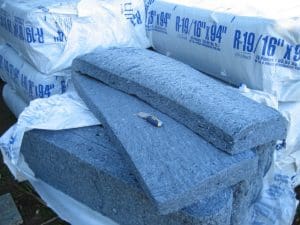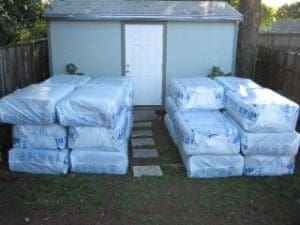Next time you pull on a pair of jeans, consider this: You can use denim to keep your house cool in the summer and warm in the winter. Though it costs nearly twice as much as fiberglass, denim insulation (also known as cotton fiber) offers significant advantages over traditional insulation materials. When you’re finished with your favorite pair of jeans, what do you do with them? If you’re like most people, you give them to a younger family member, donate them to a local charity, such as Goodwill, sell them on consignment or throw them away. Unfortunately, this last option is one we all choose too often — each year, almost 24 billion pounds (nearly 11 million metric tons) of clothing including jeans end up in landfills, where they can remain, depending on the material used and the conditions in the trash heap, for years. That’s not a very green way to handle your blues. Luckily, there’s a new use for old jeans that protects our planet and improves living conditions inside your home. It’s known as denim insulation, and it’s been finding its way into some high-profile buildings in recent months. For example, the California Academy of Sciences, a museum that stands as the very symbol of sustainable architecture, used denim for 68 percent of its insulation needs.

But what exactly is denim insulation? Is it, literally, blue jeans turned into batting, or pieces of thermal insulation? The short answer is yes, although it’s slightly more complicated than that. A company by the name of Bonded Logic developed the material over 35 years and owns patents to the manufacturing process. The end product of that process is UltraTouch Insulation, which contains 80 percent post-consumer recycled natural fibers — fibers derived directly from your stone-washed, acid-washed or perhaps never-washed denim. We’d be remiss if we didn’t mention that other companies, such as Applegate Insulation and Le Relais, for instance, have dabbled in denim insulation and will continue to do so as this insulation trend grows. In this article, we focused on Bonded’s product simply due to its longevity in the space.
Blue and Green. If sustainability is a priority in your project, you may appreciate that denim insulation is made from post-consumer recycled natural fibers in a low carbon-footprint process. Companies collect old blue jeans and resell the loose fibers to insulation manufacturers. In this way, Bonded Logic, one of the first and largest manufacturers of denim insulation, diverts an estimated 300 tons of the material away from landfills every month.
Breathe Easier. Denim can help improve indoor air quality, because it contains no VOCs (volatile organic compounds)—chemicals that may emit polluting gases that contribute to asthma and allergies.
high-performance insulation that’s made from scraps and clippings from the manufacture of denim clothing. This insulation is suitable for residential and commercial use in the same places as fiberglass or mineral wool batts would be used—between open roof rafters, ceiling joists and wall studs.
Recycled denim insulation offers these advantages over traditional fiberglass insulation:
• Sustainability. It typically contains 85 percent recycled content. Also, the natural cotton fibers are 100 percent recyclable at the end of the insulation’s usable life.
• Eco-friendliness. By using post-industrial material, companies that produce recycled denim insulation divert waste destined for landfills. One company estimates that it diverts 200 tons a month. In addition, the manufacturing process for this insulation requires much less energy than the manufacturing of fiberglass insulation.
• Excellent thermal performance. Using recycled denim insulation results in higher HVAC efficiency and lower energy bills.
• Better indoor acoustics. Denim insulation’s acoustic ratings are about 30 percent higher than those for traditional insulation, creating a quieter interior for homeowners.
• Better indoor air quality. Recycled denim contains no volatile organic compounds or formaldehyde, which off-gas and pollute a home’s indoor air.
• Improved health and safety. Installing recycled denim doesn’t irritate the skin or the respiratory tract. Moreover, the product requires no carcinogenic warning label. Typically, this insulation is treated with an EPA-approved borate solution that provides a Class A fire-resistance rating, which certifies a product as effective against severe exposure to external fires, not readily flammable and not a contributor to the spread of fire. (Borate has lower toxicity than table salt and is safe for humans and the environment.) It’s also treated with an EPA-registered fungal inhibitor for additional protection against mold, mildew and pests.

A downside to installing recycled denim insulation is that it can cost twice as much as fiberglass for similar insulation effectiveness. Environmental engineers agree, however, that the benefits of removing asthma- and allergy-triggering toxins from a home’s indoor air outweigh the increased expense.
The manufacturing of recycled denim insulation is a zero-waste process. First, scraps of denim fabric are processed to achieve a loose-fiber form that resembles cotton candy. Next, the material is treated for resistance to fire, mold, mildew and pests, blended with bonding fibers and heated. Finally, it’s cut into batts. Any scraps from the manufacturing process can be shredded and returned to the raw material supply.

